-
The Dance Class
-
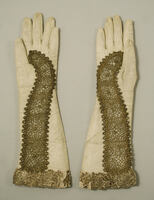 Gloves (Likely French), C. 1735
Gloves (Likely French), C. 1735 Gloves were a statement piece at society events like the opera. Often long and highly detailed, this eighteenth-century pair of gloves most likely produced in France include the ornate features typical of the fashion statement, such as its material mixture of leather and silk with intricate golden detailing.
-
 Casta Diva, Sung by Marcella Sembrich
Casta Diva, Sung by Marcella Sembrich A 1910 recording of "Casta Diva" from Vincenzo Bellini's "Norma." This song is among the most popular operatic arias, where singers from Sembrich to Jenny Lind, Rosa Ponselle, and Maria Callas performed the piece among many other prima donnas. Sopranos regularly regard Norma as one of the most challenging roles in opera.
The title translates to "Queen of Heaven" and features the title character, Norma, praying to the moon. Marcella Sembrich, who sings the solo in this recording, was among the first women to preserve their voices as commercial artists at the start of the twentieth century.
-
 Dress worn by Denyce Graves for the Washington National Opera's production of "Carmen"
Dress worn by Denyce Graves for the Washington National Opera's production of "Carmen" A costume dress designed by Donna Langman. The costume was worn by prima donna Denyce Graves for the lead and title role in a 1993-1994 production of "Carmen" for the Washington National Opera.
The costume is composed of a black corset made of silk satin with a hot pink, highly ruffled skirt made of silk taffeta and synthetic satin with a black velvet overlay. The skirt was made to represent the traditional silhouettes of Andalusian flamenco outfits, whose ruffles showed off the energetic movements of the dance style.
-
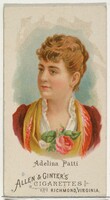 Allen & Ginter Cigarettes Trading Card, featuring Adelina Patti
Allen & Ginter Cigarettes Trading Card, featuring Adelina Patti A trading card from World's Beauties, Series 1 (N26) featuring Adelina Patti used to promote Allen & Ginter Cigarettes. These were often enjoyed as a collectible item in the nineteenth century among customers.
The card speaks to her celebrity power as she was commonly found in different advertising endorsements. Not the only tobacco company for which Patti's image has been used to advertise, she also featured on signage for companies like Sporting Extra Cigarettes.
-
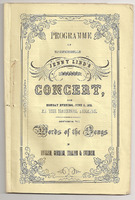 Jenny Lind Concert Program
Jenny Lind Concert Program A program for a Jenny Lind concert that was held on June 9, 1851, in Washington D. C. at the National Theater.
The program features the songs to be performed by the famous soprano Lind in four different languages. Lind was so popular throughout the United States that "Lindomania" was coined in reference to the frenzy and adoration that she often received. In an 1847 issue of the "Gazette of the Union," for example, any woman who vaguely resembled Lind was encouraged to be cautious in public as they could be mistaken for Lind and swarmed by fans.
-
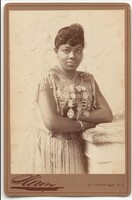 Portrait of Sissieretta Jones
Portrait of Sissieretta Jones An albumen silver print portrait of opera singer and prima donna Sissieretta Jones (January 5 1868-June 24 1933), adorned with a variety of medals on her outfit.
Jones was a classically trained soprano who performed opera and popular music throughout her career. She was also the highest-earning African-American performer during her age.
She was frequently compared to soprano Adelina Patti as the media began to call her "The Black Patti," even though she disliked the nickname given to her by critics and wanted to be known as Madame Jones. In addition to performing, she also successfully formed her own performance troupe that enjoyed popularity throughout North America.
-
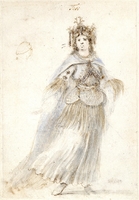 Costume design for Thetis from Cavalli's L'Hipermestra
Costume design for Thetis from Cavalli's L'Hipermestra Costume design for the character of Thetis in Cavalli's opera L'Hipermestra. The design displays the attention to detail and care paid to costuming in the midst of Opera's rise in Italy during the early 17th century. A nymph of the sea, Thetis's costume features design choices such as scallop-shells and a head-piece made of coral and shell with fine line detailing.
Cavalli was a leading composer of 17th-century Italian public opera, where the performing art style flourished before spreading across Europe.
-
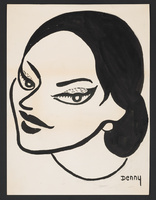 "Maria Callas" by Diana Denny
"Maria Callas" by Diana Denny An ink-wash portrait of twentieth-century prima donna Maria Callas by Diana Denny. The artwork's ink-wash style is monochrome and represents Callas in a profile view, smirking slightly at her viewers.
Callas remains one of the most well-known prima donnas, praised for both her bel canto-style soprano vocals and often critiqued in the public eye for her private life.
-
 Satirical Drawing of Adelina Patti in Le Voltaire
Satirical Drawing of Adelina Patti in Le Voltaire This satirical drawing created by lithographer André Gill in "Le Voltaire, " La Diva Adelina Patti, compares prima donna Adelina Patti to a cat. Pictured on stage mid-song, coins appear to be spewing out of her mouth and into the hat of a conductor, while in the background, another cat can be seen in a position evoking fear, possibly signalling a critique of Patti's vocals.
-
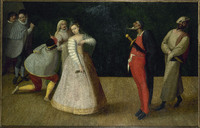 Commedia dell'Arte Troupe (I Gelosi?)
Commedia dell'Arte Troupe (I Gelosi?) This late sixteenth century oil painting depicts a commedia dell'arte acting troupe thought to be I Gelosi. I Gelosi was one of the premier acting troups in Renaissance-era Milan and enjoyed the patronage of nobility.
The central woman figure in the cream gown is presumed to be prima donna Isabella Andreini, the namesake of the stock character Isabella and leading lady of the troupe. Along with her husband and fellow actor Francesco Andreini, she helped manage the troupe in addition to receiving public acclaim as an actress. Some of the first prima donnas who became public celebrities performed in commedia dell'arte in a rare public-facing profession for women.
In the painting, Andreini and the rest of her troupe are performing a scene on stage. Andreini is the only figure in the work looking directly at viewers, reflecting the connections that her audiences felt to her.
-
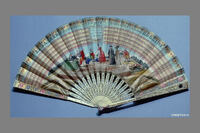 Barber of Seville Opera Fan
Barber of Seville Opera Fan An opera fan designed and printed by the Parisian fan-maker Fernando Coustellier that pays tribute to Rossini's opera, "The Barber of Seville." The fan features characters from the opera as well as part of its score in an intricate design, as they were often used as dual-purpose fashion statements and heat-relieving tools at the opera.
-
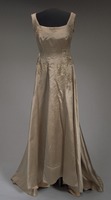 Light Bronze Satin gown worn by Marian Anderson and Denyce Graves
Light Bronze Satin gown worn by Marian Anderson and Denyce Graves This light bronze gown was created by Ukranian designer Barbara Karinska to be worn by prima donna and contralto Marian Anderson (1897-1993).
The dress is made of slubbed silk satin with golden detailing around the bust, waistline, and hip areas of the dress. Later, the gown was altered and worn by another prima donna, Denyce Graves.
-
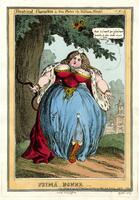 William Heath's "Prima Donna"
William Heath's "Prima Donna" Satirical caricature of an operatic prima donna singing by William Heath (1795-1840). The singer holds a bow in a reference to the classical tales and characters that operas were often based on like the goddess Diana.
She sings a line from the comic opera "The Duenna," composed by Thomas Linley the Elder and Thomas Linley the younger with a libretto by Richard Brinsely Sheridan.
-
 Adelina Patti as Esmeralda
Adelina Patti as Esmeralda Color lithograph of Italian prima donna Adelina Patti (February 19, 1843- September 27, 1919) as Esmeralda wearing a gown with gold, black, and red detailing published by M. & N. Hanhart. Patti was born Adela Juana Maria Patti and was an acclaimed soprano of the nineteenth century.
Esmeralda, a character from Victor Hugo's The Hunchback of Notre-Dame, received wide attention throughout the nineteenth century, featuring as the title role in Fabio Campana's opera of the same name.
-
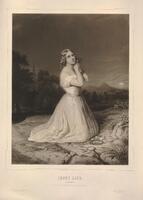 Jenny Lind as Amina
Jenny Lind as Amina This print depicts Swedish soprano Jenny Lind as Amina from the opera "La Sonnambula." She is wearing a lightly colored gown while kneeling on the ground and clasping her hands together holding flowers within them, evoking images of the wildflowers that her love Elvino gave her as a token of his love for her in the story.
-
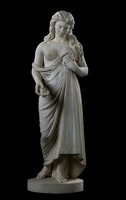 The Sonnambula
The Sonnambula Marble sculpture depicting a character named Amina.
Crafted in 1855, the sculpture likely refers to the Amina character from Bellini's "La Sonnambula," which premiered in Milan about two decades prior to Rogers's creation. In the opera, Amina's sleepwalking is misperceived as a betrayal by her love Elvino when she sleepwalks into another man's room. The sculpture thus represents her in her sleeping state.
-
 Satirical Print of Cuzzoni, Farinelli, and Heidegger
Satirical Print of Cuzzoni, Farinelli, and Heidegger This satirical print depicts opera singers Francesca Cuzzoni (left) with Farinelli (center) accompanied by the Impresario John James Heidegger.
Accompanied by the etching are words spoken by Heidegger regarding the decline of the opera in favor of gatherings like masquerades, describing that Cuzzoni has "no shelter" to house her voice while "Balls & Masquerades Triumphant Reign."
-
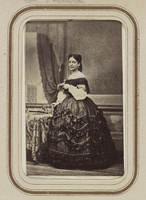 Full-Length Portrait of Ángela Peralta
Full-Length Portrait of Ángela Peralta This photograph created between 1870 and 1880 captures a full-length portrait of Mexican operatic prima donna Ángela Peralta (Mexican, 6 July 1845-30 August 1883). Peralta was also known as the "Mexican Nightingale" and achieved fame in her home country and Europe for her melodic soprano vocals. Throughout her lifetime, she performed in roles such as "Norma's" Norma, Violetta in "La Traviata," and Leonora in "Il Trovatore," among others.
This albumen print features Peralta during a period of her career in which she created her own operatic touring company. In the photo, she faces the front at a slight angle, wearing an ornate, darkly colored off-the-shoulder gown adorned with lacework on the bodice and ruffled tiers of fabric on the skirt.
French photographer André-Adolphe-Eugène Disdéri patented the carte-de-visite medium in 1854. The technique included albumen prints that were mounted on a card, and they rose in popularity during the mid-nineteenth century. They were especially popular for their frequent celebrity subjects and were often traded during special occasions or kept as collectibles. As such, the photograph itself reflects Peralta's fame at the time.
-
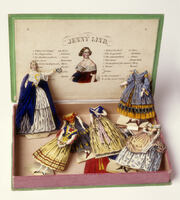 Jenny Lind Paper Doll Set
Jenny Lind Paper Doll Set This mid-nineteenth century paper doll set features costumes from various performances by Jenny Lind (Swedish, 6 October 1820-2 November 1887). Lind's soprano voice earned her the nickname "Swedish Nightingale" as she propelled into super-stardom across Europe and the United States during her lifetime.
The ten costumes (lithograph on white wove paper) included in the set are meant to be placed over a paper doll. Each costume is named in English or German on the topside interior of the cardboard box. One of the costumes represents the character Norma from Vincenzo Bellini's opera "Norma," with a royal blue cape draped over a white dress with golden accessories (left-side vertical). Norma is often considered one of the definitive soprano roles, and became associated with many world-famous prima donnas who performed as her.
-
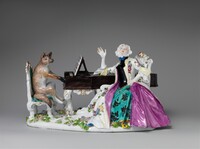 Faustina Bordoni and Fox
Faustina Bordoni and Fox This ceramics-porcelain figure created by Meissen Manufactory modeler Johann Joachim Kändler portrays mid eighteenth-century opera star Faustina Bordoni (30 March 1697-4 November 1781) singing while sitting across from a fox playing the harpsichord. An acclaimed Italian mezzo-soprano, Bordoni was especially well-known in Dresden operatic circles along with her husband, the celebrated German composer Johann Adolph Hasse, who both performed in the Saxon court of Augustus II.
The couple's high-profile status in Dresden society also garnered critical attention from people like Kändler, whose satirical inclusion of the fox figure references a man named Herr Fuchs (AKA Mr. Fox). Bordoni and Fuchs engaged in a love affair that was highly publicized, with this figure reflecting the popularity of the opera star's public —as well as private— life.
In addition to the carefully decorated floral designs on the figure's base and Bordoni's skirt, viewers can observe the extreme attention to detail that supports Kändler's reputation as a major influence in European porcelain work through the carefully painted Italian lyrics that can be read on the sheet music. Within, the composer that the fox plays is named as Bordoni's husband, Hasse.
 Gloves (Likely French), C. 1735 Gloves were a statement piece at society events like the opera. Often long and highly detailed, this eighteenth-century pair of gloves most likely produced in France include the ornate features typical of the fashion statement, such as its material mixture of leather and silk with intricate golden detailing.
Gloves (Likely French), C. 1735 Gloves were a statement piece at society events like the opera. Often long and highly detailed, this eighteenth-century pair of gloves most likely produced in France include the ornate features typical of the fashion statement, such as its material mixture of leather and silk with intricate golden detailing. Casta Diva, Sung by Marcella Sembrich A 1910 recording of "Casta Diva" from Vincenzo Bellini's "Norma." This song is among the most popular operatic arias, where singers from Sembrich to Jenny Lind, Rosa Ponselle, and Maria Callas performed the piece among many other prima donnas. Sopranos regularly regard Norma as one of the most challenging roles in opera. The title translates to "Queen of Heaven" and features the title character, Norma, praying to the moon. Marcella Sembrich, who sings the solo in this recording, was among the first women to preserve their voices as commercial artists at the start of the twentieth century.
Casta Diva, Sung by Marcella Sembrich A 1910 recording of "Casta Diva" from Vincenzo Bellini's "Norma." This song is among the most popular operatic arias, where singers from Sembrich to Jenny Lind, Rosa Ponselle, and Maria Callas performed the piece among many other prima donnas. Sopranos regularly regard Norma as one of the most challenging roles in opera. The title translates to "Queen of Heaven" and features the title character, Norma, praying to the moon. Marcella Sembrich, who sings the solo in this recording, was among the first women to preserve their voices as commercial artists at the start of the twentieth century. Dress worn by Denyce Graves for the Washington National Opera's production of "Carmen" A costume dress designed by Donna Langman. The costume was worn by prima donna Denyce Graves for the lead and title role in a 1993-1994 production of "Carmen" for the Washington National Opera. The costume is composed of a black corset made of silk satin with a hot pink, highly ruffled skirt made of silk taffeta and synthetic satin with a black velvet overlay. The skirt was made to represent the traditional silhouettes of Andalusian flamenco outfits, whose ruffles showed off the energetic movements of the dance style.
Dress worn by Denyce Graves for the Washington National Opera's production of "Carmen" A costume dress designed by Donna Langman. The costume was worn by prima donna Denyce Graves for the lead and title role in a 1993-1994 production of "Carmen" for the Washington National Opera. The costume is composed of a black corset made of silk satin with a hot pink, highly ruffled skirt made of silk taffeta and synthetic satin with a black velvet overlay. The skirt was made to represent the traditional silhouettes of Andalusian flamenco outfits, whose ruffles showed off the energetic movements of the dance style. Allen & Ginter Cigarettes Trading Card, featuring Adelina Patti A trading card from World's Beauties, Series 1 (N26) featuring Adelina Patti used to promote Allen & Ginter Cigarettes. These were often enjoyed as a collectible item in the nineteenth century among customers. The card speaks to her celebrity power as she was commonly found in different advertising endorsements. Not the only tobacco company for which Patti's image has been used to advertise, she also featured on signage for companies like Sporting Extra Cigarettes.
Allen & Ginter Cigarettes Trading Card, featuring Adelina Patti A trading card from World's Beauties, Series 1 (N26) featuring Adelina Patti used to promote Allen & Ginter Cigarettes. These were often enjoyed as a collectible item in the nineteenth century among customers. The card speaks to her celebrity power as she was commonly found in different advertising endorsements. Not the only tobacco company for which Patti's image has been used to advertise, she also featured on signage for companies like Sporting Extra Cigarettes. Jenny Lind Concert Program A program for a Jenny Lind concert that was held on June 9, 1851, in Washington D. C. at the National Theater. The program features the songs to be performed by the famous soprano Lind in four different languages. Lind was so popular throughout the United States that "Lindomania" was coined in reference to the frenzy and adoration that she often received. In an 1847 issue of the "Gazette of the Union," for example, any woman who vaguely resembled Lind was encouraged to be cautious in public as they could be mistaken for Lind and swarmed by fans.
Jenny Lind Concert Program A program for a Jenny Lind concert that was held on June 9, 1851, in Washington D. C. at the National Theater. The program features the songs to be performed by the famous soprano Lind in four different languages. Lind was so popular throughout the United States that "Lindomania" was coined in reference to the frenzy and adoration that she often received. In an 1847 issue of the "Gazette of the Union," for example, any woman who vaguely resembled Lind was encouraged to be cautious in public as they could be mistaken for Lind and swarmed by fans. Portrait of Sissieretta Jones An albumen silver print portrait of opera singer and prima donna Sissieretta Jones (January 5 1868-June 24 1933), adorned with a variety of medals on her outfit. Jones was a classically trained soprano who performed opera and popular music throughout her career. She was also the highest-earning African-American performer during her age. She was frequently compared to soprano Adelina Patti as the media began to call her "The Black Patti," even though she disliked the nickname given to her by critics and wanted to be known as Madame Jones. In addition to performing, she also successfully formed her own performance troupe that enjoyed popularity throughout North America.
Portrait of Sissieretta Jones An albumen silver print portrait of opera singer and prima donna Sissieretta Jones (January 5 1868-June 24 1933), adorned with a variety of medals on her outfit. Jones was a classically trained soprano who performed opera and popular music throughout her career. She was also the highest-earning African-American performer during her age. She was frequently compared to soprano Adelina Patti as the media began to call her "The Black Patti," even though she disliked the nickname given to her by critics and wanted to be known as Madame Jones. In addition to performing, she also successfully formed her own performance troupe that enjoyed popularity throughout North America. Costume design for Thetis from Cavalli's L'Hipermestra Costume design for the character of Thetis in Cavalli's opera L'Hipermestra. The design displays the attention to detail and care paid to costuming in the midst of Opera's rise in Italy during the early 17th century. A nymph of the sea, Thetis's costume features design choices such as scallop-shells and a head-piece made of coral and shell with fine line detailing. Cavalli was a leading composer of 17th-century Italian public opera, where the performing art style flourished before spreading across Europe.
Costume design for Thetis from Cavalli's L'Hipermestra Costume design for the character of Thetis in Cavalli's opera L'Hipermestra. The design displays the attention to detail and care paid to costuming in the midst of Opera's rise in Italy during the early 17th century. A nymph of the sea, Thetis's costume features design choices such as scallop-shells and a head-piece made of coral and shell with fine line detailing. Cavalli was a leading composer of 17th-century Italian public opera, where the performing art style flourished before spreading across Europe. "Maria Callas" by Diana Denny An ink-wash portrait of twentieth-century prima donna Maria Callas by Diana Denny. The artwork's ink-wash style is monochrome and represents Callas in a profile view, smirking slightly at her viewers. Callas remains one of the most well-known prima donnas, praised for both her bel canto-style soprano vocals and often critiqued in the public eye for her private life.
"Maria Callas" by Diana Denny An ink-wash portrait of twentieth-century prima donna Maria Callas by Diana Denny. The artwork's ink-wash style is monochrome and represents Callas in a profile view, smirking slightly at her viewers. Callas remains one of the most well-known prima donnas, praised for both her bel canto-style soprano vocals and often critiqued in the public eye for her private life. Satirical Drawing of Adelina Patti in Le Voltaire This satirical drawing created by lithographer André Gill in "Le Voltaire, " La Diva Adelina Patti, compares prima donna Adelina Patti to a cat. Pictured on stage mid-song, coins appear to be spewing out of her mouth and into the hat of a conductor, while in the background, another cat can be seen in a position evoking fear, possibly signalling a critique of Patti's vocals.
Satirical Drawing of Adelina Patti in Le Voltaire This satirical drawing created by lithographer André Gill in "Le Voltaire, " La Diva Adelina Patti, compares prima donna Adelina Patti to a cat. Pictured on stage mid-song, coins appear to be spewing out of her mouth and into the hat of a conductor, while in the background, another cat can be seen in a position evoking fear, possibly signalling a critique of Patti's vocals. Commedia dell'Arte Troupe (I Gelosi?) This late sixteenth century oil painting depicts a commedia dell'arte acting troupe thought to be I Gelosi. I Gelosi was one of the premier acting troups in Renaissance-era Milan and enjoyed the patronage of nobility. The central woman figure in the cream gown is presumed to be prima donna Isabella Andreini, the namesake of the stock character Isabella and leading lady of the troupe. Along with her husband and fellow actor Francesco Andreini, she helped manage the troupe in addition to receiving public acclaim as an actress. Some of the first prima donnas who became public celebrities performed in commedia dell'arte in a rare public-facing profession for women. In the painting, Andreini and the rest of her troupe are performing a scene on stage. Andreini is the only figure in the work looking directly at viewers, reflecting the connections that her audiences felt to her.
Commedia dell'Arte Troupe (I Gelosi?) This late sixteenth century oil painting depicts a commedia dell'arte acting troupe thought to be I Gelosi. I Gelosi was one of the premier acting troups in Renaissance-era Milan and enjoyed the patronage of nobility. The central woman figure in the cream gown is presumed to be prima donna Isabella Andreini, the namesake of the stock character Isabella and leading lady of the troupe. Along with her husband and fellow actor Francesco Andreini, she helped manage the troupe in addition to receiving public acclaim as an actress. Some of the first prima donnas who became public celebrities performed in commedia dell'arte in a rare public-facing profession for women. In the painting, Andreini and the rest of her troupe are performing a scene on stage. Andreini is the only figure in the work looking directly at viewers, reflecting the connections that her audiences felt to her. Barber of Seville Opera Fan An opera fan designed and printed by the Parisian fan-maker Fernando Coustellier that pays tribute to Rossini's opera, "The Barber of Seville." The fan features characters from the opera as well as part of its score in an intricate design, as they were often used as dual-purpose fashion statements and heat-relieving tools at the opera.
Barber of Seville Opera Fan An opera fan designed and printed by the Parisian fan-maker Fernando Coustellier that pays tribute to Rossini's opera, "The Barber of Seville." The fan features characters from the opera as well as part of its score in an intricate design, as they were often used as dual-purpose fashion statements and heat-relieving tools at the opera. Light Bronze Satin gown worn by Marian Anderson and Denyce Graves This light bronze gown was created by Ukranian designer Barbara Karinska to be worn by prima donna and contralto Marian Anderson (1897-1993). The dress is made of slubbed silk satin with golden detailing around the bust, waistline, and hip areas of the dress. Later, the gown was altered and worn by another prima donna, Denyce Graves.
Light Bronze Satin gown worn by Marian Anderson and Denyce Graves This light bronze gown was created by Ukranian designer Barbara Karinska to be worn by prima donna and contralto Marian Anderson (1897-1993). The dress is made of slubbed silk satin with golden detailing around the bust, waistline, and hip areas of the dress. Later, the gown was altered and worn by another prima donna, Denyce Graves. William Heath's "Prima Donna" Satirical caricature of an operatic prima donna singing by William Heath (1795-1840). The singer holds a bow in a reference to the classical tales and characters that operas were often based on like the goddess Diana. She sings a line from the comic opera "The Duenna," composed by Thomas Linley the Elder and Thomas Linley the younger with a libretto by Richard Brinsely Sheridan.
William Heath's "Prima Donna" Satirical caricature of an operatic prima donna singing by William Heath (1795-1840). The singer holds a bow in a reference to the classical tales and characters that operas were often based on like the goddess Diana. She sings a line from the comic opera "The Duenna," composed by Thomas Linley the Elder and Thomas Linley the younger with a libretto by Richard Brinsely Sheridan. Adelina Patti as Esmeralda Color lithograph of Italian prima donna Adelina Patti (February 19, 1843- September 27, 1919) as Esmeralda wearing a gown with gold, black, and red detailing published by M. & N. Hanhart. Patti was born Adela Juana Maria Patti and was an acclaimed soprano of the nineteenth century. Esmeralda, a character from Victor Hugo's The Hunchback of Notre-Dame, received wide attention throughout the nineteenth century, featuring as the title role in Fabio Campana's opera of the same name.
Adelina Patti as Esmeralda Color lithograph of Italian prima donna Adelina Patti (February 19, 1843- September 27, 1919) as Esmeralda wearing a gown with gold, black, and red detailing published by M. & N. Hanhart. Patti was born Adela Juana Maria Patti and was an acclaimed soprano of the nineteenth century. Esmeralda, a character from Victor Hugo's The Hunchback of Notre-Dame, received wide attention throughout the nineteenth century, featuring as the title role in Fabio Campana's opera of the same name. Jenny Lind as Amina This print depicts Swedish soprano Jenny Lind as Amina from the opera "La Sonnambula." She is wearing a lightly colored gown while kneeling on the ground and clasping her hands together holding flowers within them, evoking images of the wildflowers that her love Elvino gave her as a token of his love for her in the story.
Jenny Lind as Amina This print depicts Swedish soprano Jenny Lind as Amina from the opera "La Sonnambula." She is wearing a lightly colored gown while kneeling on the ground and clasping her hands together holding flowers within them, evoking images of the wildflowers that her love Elvino gave her as a token of his love for her in the story. The Sonnambula Marble sculpture depicting a character named Amina. Crafted in 1855, the sculpture likely refers to the Amina character from Bellini's "La Sonnambula," which premiered in Milan about two decades prior to Rogers's creation. In the opera, Amina's sleepwalking is misperceived as a betrayal by her love Elvino when she sleepwalks into another man's room. The sculpture thus represents her in her sleeping state.
The Sonnambula Marble sculpture depicting a character named Amina. Crafted in 1855, the sculpture likely refers to the Amina character from Bellini's "La Sonnambula," which premiered in Milan about two decades prior to Rogers's creation. In the opera, Amina's sleepwalking is misperceived as a betrayal by her love Elvino when she sleepwalks into another man's room. The sculpture thus represents her in her sleeping state. Satirical Print of Cuzzoni, Farinelli, and Heidegger This satirical print depicts opera singers Francesca Cuzzoni (left) with Farinelli (center) accompanied by the Impresario John James Heidegger. Accompanied by the etching are words spoken by Heidegger regarding the decline of the opera in favor of gatherings like masquerades, describing that Cuzzoni has "no shelter" to house her voice while "Balls & Masquerades Triumphant Reign."
Satirical Print of Cuzzoni, Farinelli, and Heidegger This satirical print depicts opera singers Francesca Cuzzoni (left) with Farinelli (center) accompanied by the Impresario John James Heidegger. Accompanied by the etching are words spoken by Heidegger regarding the decline of the opera in favor of gatherings like masquerades, describing that Cuzzoni has "no shelter" to house her voice while "Balls & Masquerades Triumphant Reign." Full-Length Portrait of Ángela Peralta This photograph created between 1870 and 1880 captures a full-length portrait of Mexican operatic prima donna Ángela Peralta (Mexican, 6 July 1845-30 August 1883). Peralta was also known as the "Mexican Nightingale" and achieved fame in her home country and Europe for her melodic soprano vocals. Throughout her lifetime, she performed in roles such as "Norma's" Norma, Violetta in "La Traviata," and Leonora in "Il Trovatore," among others. This albumen print features Peralta during a period of her career in which she created her own operatic touring company. In the photo, she faces the front at a slight angle, wearing an ornate, darkly colored off-the-shoulder gown adorned with lacework on the bodice and ruffled tiers of fabric on the skirt. French photographer André-Adolphe-Eugène Disdéri patented the carte-de-visite medium in 1854. The technique included albumen prints that were mounted on a card, and they rose in popularity during the mid-nineteenth century. They were especially popular for their frequent celebrity subjects and were often traded during special occasions or kept as collectibles. As such, the photograph itself reflects Peralta's fame at the time.
Full-Length Portrait of Ángela Peralta This photograph created between 1870 and 1880 captures a full-length portrait of Mexican operatic prima donna Ángela Peralta (Mexican, 6 July 1845-30 August 1883). Peralta was also known as the "Mexican Nightingale" and achieved fame in her home country and Europe for her melodic soprano vocals. Throughout her lifetime, she performed in roles such as "Norma's" Norma, Violetta in "La Traviata," and Leonora in "Il Trovatore," among others. This albumen print features Peralta during a period of her career in which she created her own operatic touring company. In the photo, she faces the front at a slight angle, wearing an ornate, darkly colored off-the-shoulder gown adorned with lacework on the bodice and ruffled tiers of fabric on the skirt. French photographer André-Adolphe-Eugène Disdéri patented the carte-de-visite medium in 1854. The technique included albumen prints that were mounted on a card, and they rose in popularity during the mid-nineteenth century. They were especially popular for their frequent celebrity subjects and were often traded during special occasions or kept as collectibles. As such, the photograph itself reflects Peralta's fame at the time. Jenny Lind Paper Doll Set This mid-nineteenth century paper doll set features costumes from various performances by Jenny Lind (Swedish, 6 October 1820-2 November 1887). Lind's soprano voice earned her the nickname "Swedish Nightingale" as she propelled into super-stardom across Europe and the United States during her lifetime. The ten costumes (lithograph on white wove paper) included in the set are meant to be placed over a paper doll. Each costume is named in English or German on the topside interior of the cardboard box. One of the costumes represents the character Norma from Vincenzo Bellini's opera "Norma," with a royal blue cape draped over a white dress with golden accessories (left-side vertical). Norma is often considered one of the definitive soprano roles, and became associated with many world-famous prima donnas who performed as her.
Jenny Lind Paper Doll Set This mid-nineteenth century paper doll set features costumes from various performances by Jenny Lind (Swedish, 6 October 1820-2 November 1887). Lind's soprano voice earned her the nickname "Swedish Nightingale" as she propelled into super-stardom across Europe and the United States during her lifetime. The ten costumes (lithograph on white wove paper) included in the set are meant to be placed over a paper doll. Each costume is named in English or German on the topside interior of the cardboard box. One of the costumes represents the character Norma from Vincenzo Bellini's opera "Norma," with a royal blue cape draped over a white dress with golden accessories (left-side vertical). Norma is often considered one of the definitive soprano roles, and became associated with many world-famous prima donnas who performed as her. Faustina Bordoni and Fox This ceramics-porcelain figure created by Meissen Manufactory modeler Johann Joachim Kändler portrays mid eighteenth-century opera star Faustina Bordoni (30 March 1697-4 November 1781) singing while sitting across from a fox playing the harpsichord. An acclaimed Italian mezzo-soprano, Bordoni was especially well-known in Dresden operatic circles along with her husband, the celebrated German composer Johann Adolph Hasse, who both performed in the Saxon court of Augustus II. The couple's high-profile status in Dresden society also garnered critical attention from people like Kändler, whose satirical inclusion of the fox figure references a man named Herr Fuchs (AKA Mr. Fox). Bordoni and Fuchs engaged in a love affair that was highly publicized, with this figure reflecting the popularity of the opera star's public —as well as private— life. In addition to the carefully decorated floral designs on the figure's base and Bordoni's skirt, viewers can observe the extreme attention to detail that supports Kändler's reputation as a major influence in European porcelain work through the carefully painted Italian lyrics that can be read on the sheet music. Within, the composer that the fox plays is named as Bordoni's husband, Hasse.
Faustina Bordoni and Fox This ceramics-porcelain figure created by Meissen Manufactory modeler Johann Joachim Kändler portrays mid eighteenth-century opera star Faustina Bordoni (30 March 1697-4 November 1781) singing while sitting across from a fox playing the harpsichord. An acclaimed Italian mezzo-soprano, Bordoni was especially well-known in Dresden operatic circles along with her husband, the celebrated German composer Johann Adolph Hasse, who both performed in the Saxon court of Augustus II. The couple's high-profile status in Dresden society also garnered critical attention from people like Kändler, whose satirical inclusion of the fox figure references a man named Herr Fuchs (AKA Mr. Fox). Bordoni and Fuchs engaged in a love affair that was highly publicized, with this figure reflecting the popularity of the opera star's public —as well as private— life. In addition to the carefully decorated floral designs on the figure's base and Bordoni's skirt, viewers can observe the extreme attention to detail that supports Kändler's reputation as a major influence in European porcelain work through the carefully painted Italian lyrics that can be read on the sheet music. Within, the composer that the fox plays is named as Bordoni's husband, Hasse.